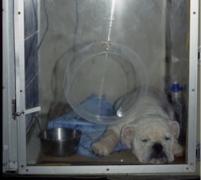Managing Tracheal Collapse in your Dog

Managing Tracheal Collapse in your Dog
A Facebook friend of The Animal Medical Center posted a question asking how they might prevent tracheal collapse in their dog. Unfortunately, tracheal collapse may not be preventable, but dog owners can help lessen the impact of a collapsing trachea on their dog’s quality of life. Since tracheal collapse is an important problem in dogs and is likely to flare up more now that spring is here, I have expanded on my Facebook response for the readers of Fur the Love of Pets.
The problem
If you are a large dog owner, you may not know what tracheal collapse is since the disorder is most common in toy and miniature breed dogs – Chihuahuas, Pomeranians, Poodles, Shih tzus, Lhasa apsos, and Yorkies. In a normal dog, the tubular shape of the trachea comes from cartilage in the C-shaped tracheal rings. The two ends of the C are joined by a soft membrane completing the circle. In dogs with tracheal collapse, the cartilage loses it rigidity and becomes flabby. The flabby rings pull on the soft membrane, stretching it and flattening the tubular trachea into an oval with a narrow inner dimension. With each inspiration, the flabby trachea collapses, producing noisy respirations and a cough. Sometimes the cough progresses to full-blown respiratory distress requiring a trip to the animal ER for a stay in an oxygen cage pictured above.
Weight control
Overweight dogs have more difficulty breathing and being overweight contributes to the chronic cough typical of tracheal collapse. If your dog is already overweight, see your veterinarian to develop a plan of diet and exercise to take off the extra pounds. In a small dog like a Yorkie, 1/4-1/2 pound of weight loss may make a big difference.
Change your restraint method
Use a harness and not a collar when walking your dog. You may want a collar for the ID tags (and don’t forget the microchip too) but hook the leash to a harness, which pulls less on the throat and neck. Less pulling usually means less coughing.
Avoid heat and humidity
As the weather warms up and the humidity climbs, owners of dogs with tracheal collapse will begin to worry about the impact of heat and humidity on their dogs’ respirations. When it is hot outside your dog should be inside if she is one with tracheal collapse. Every veterinarian will tell you when the humidity is up, coughing increases and the oxygen cages in animal ERs are full. To prevent your dog from being in the ER oxygen cage, take them out only in the cool of the early morning or late evening to avoid provoking coughing spells instigated by breathing heavy, wet summer air. Keep your dog in the air conditioning on days the air can be cut with a knife.
For other tips to prevent heat-related health issues in your pet, click here.




































